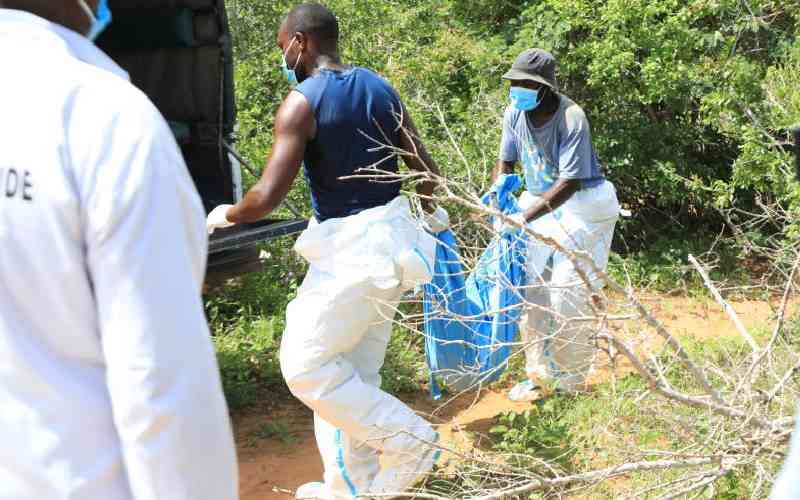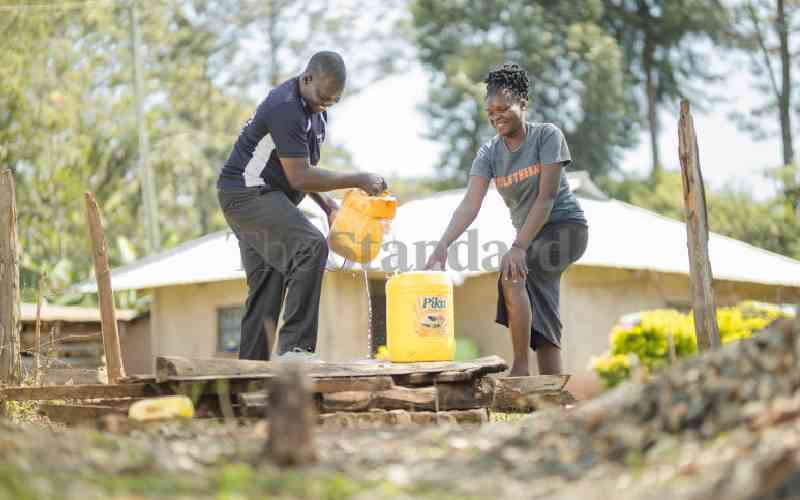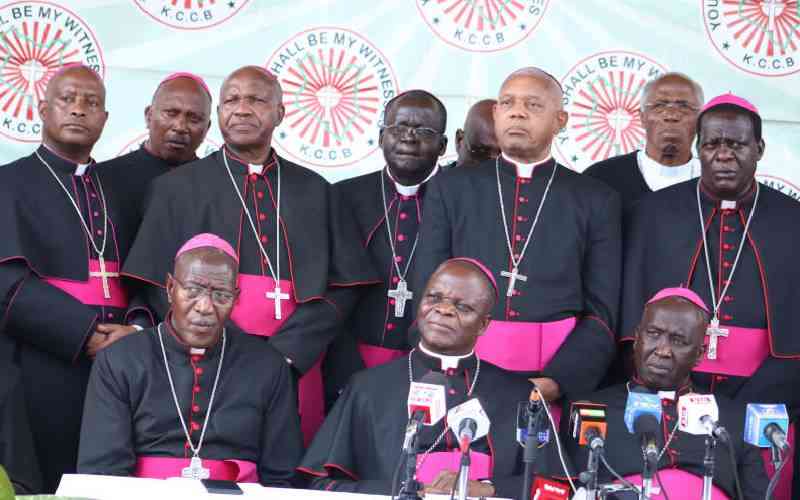
Chairman of Kaya Mrima Ali Mohamed Nasiri and Coast Forest Association Secretary Ayubu Suya during an interview near Mrima Forest in Kwale County [Omondi Onyango, Standard]
For ages, tales have been whispered told about Kaya elders’ deeply held secrets that protect the Mijikenda tribe at the Coast from adversaries.
Most of these stories could perhaps be tall tales to intrigue tourists or scare away developers of all stripes hungering after land and minerals at the Coast. But for the villagers living on the foot of Mrima Hill forest in Kwale, these Kaya rites have worked thus far to keep global mining firms at bay from their forest.
Scholarly articles show at least five global mining firms have since 1952 tried to dig up Mrima Hill to extract huge mineral deposits beneath. In 2013, Cortec Kenya Limited was given a permit to extract the rare earth mineral deposits worth Sh7.2 trillion ($62.4 billion) at Mrima Hill forest.
The firm also confirmed the existence of niobium deposits estimated to be worth Sh4 trillion ($35 billion) in Mrima. But the venture failed to take off. In 1953, Anglo American Corporation also carried out exploration at Mrima. It said that this was after it was discovered that the area has Gold deposits.
But for locals in the five villages of Mrima Hill, the forest is a gem they will fight for through the courts, spiritually and physically. But why? Mrima which is located about 60km west of the Mombasa-Lungalunga road and has extremely rare diverse foliage.
Mrima hosts six of 50 most revered Kayas, sacred places for the Mijikenda people, according to Mzee Ali Mohamed Mwatsimbu of Kaya Chigongo. It is also home to 47 species of birds like the rare Orange Ground Thrush, according to Kenya Wildlife Services and other independent scholars.
Renowned botanists, like the late Bernard Verdcourt have also descended on the forest to study rare types of trees towering into the sky at Mrima. It is documented that Mr Verdcourt’s interest was the in rare Gigasiphon macrosiphon tree, locally called the mnyanza.
But this is before loggers sneaked into the sacred grove and hewed down ageless trees into logs and timber or burn charcoal. Along the edges of Mrima, encroachers have hoed and fenced the forest land. Elders say most trees were felled between 1989 and 1992. Inside the forest one could also not fail to notice deep test holes dug by geologists exploring for minerals like Cortec Kenya Limited.
“We have fought spiritually, legally, and physically to protect this forest. But the appetite from forces keen to turn the hill upside down persists,” said Kaya Chigongoni chairman Mzee Ali Mohamed Mwatsimbu.

Sacred grove
Mzee Mwatsimbu sipped a green concoction from a gourd, slightly grimaced as he gazed at the forest and declared: “This is why we jealously guard this sacred grove. The trees are medicinal.”
Kaya Chigongoni is the main shrine. Other Kayas are Beje, Mwagangwa Kuza, Genja Mwambini, Kijiwene and Mzimani. Each Kaya has a unique task but they must all conduct a ritual for the protection of the forest.
“There are a total of 23 medicinal plants in Mrima Hill. It is our responsibility to protect and nurture these trees. We have come up with a strict code on the use of these trees,” said another elder Bakari Bege.
Inside the Mrima Hill forest, there are trees villagers cannot cut down. A family that cuts down the tree for charcoal, firewood, and timber will be cursed, said another elder Mr Ayubu Suyu.
“We protected the forest using our traditions and taboos, and enforce them through ceremonies and rituals,” said Suyu who is the Secretary of Mrima Community Forest Association.
He said a cow, sheep, and goat that find their way into prohibited areas must be slaughtered and eaten within the forest. “This protests endangered shrubs or trees from destruction,” he said.
“No one should use medicinal trees as firewood or burn charcoals. The smoke of these trees invites bad omen or calamities to the family,” said Suyu.
Mzee Mwatsimbu said those who cut down prohibited trees must undergo a costly cleansing ceremony conducted by the elders inside the shrines. A family can be required to provide a cow, sheep, chicken, or both for the ritual of the sacrifice. The meat is eaten inside the forest by the elders. These are traditional codes of ethics that the Digo and nine Mijikenda sub-tribes use to keep illegal loggers, poachers, and encroachers at bay.
“The use of metal drills in the forest is not permitted. Mining firms are restricted from blowing the forest as they disturb the ancestors,” said another elder Bakari Bege.
Mwatsimbu admits that it has not been easy to protect such a rare scared grove for centuries without a single dent owing to increased interest from both local and international forces.
Mrima Hill forest has since 1952 been the subject of exploration by global firms from the U.S.A, Australia, Canada, France, and South Africa keen to extract minerals beneath the shrines.
 The Standard Group Plc is a multi-media organization with investments in media platforms spanning newspaper print
operations, television, radio broadcasting, digital and online services. The Standard Group is recognized as a
leading multi-media house in Kenya with a key influence in matters of national and international interest.
The Standard Group Plc is a multi-media organization with investments in media platforms spanning newspaper print
operations, television, radio broadcasting, digital and online services. The Standard Group is recognized as a
leading multi-media house in Kenya with a key influence in matters of national and international interest.











